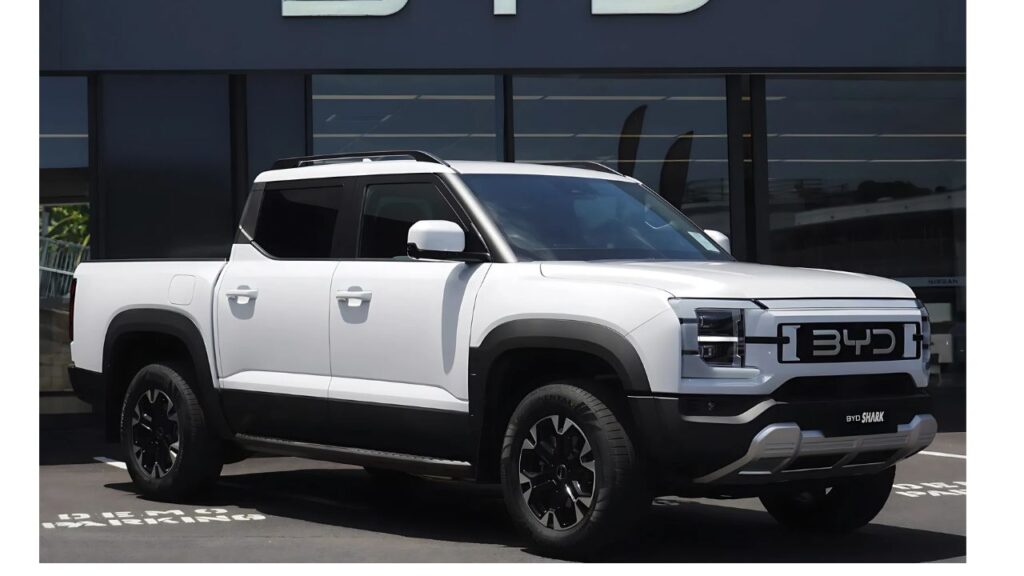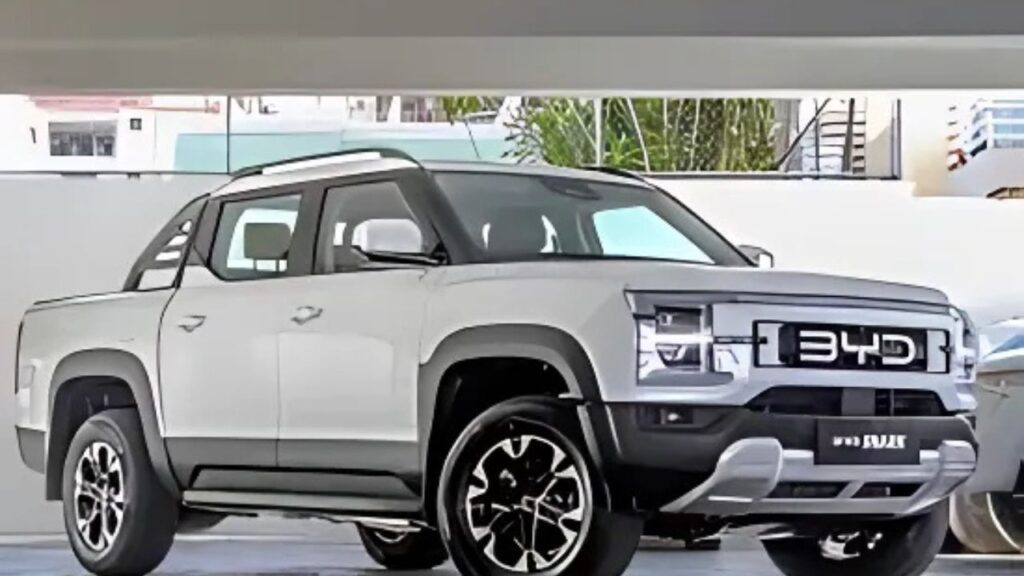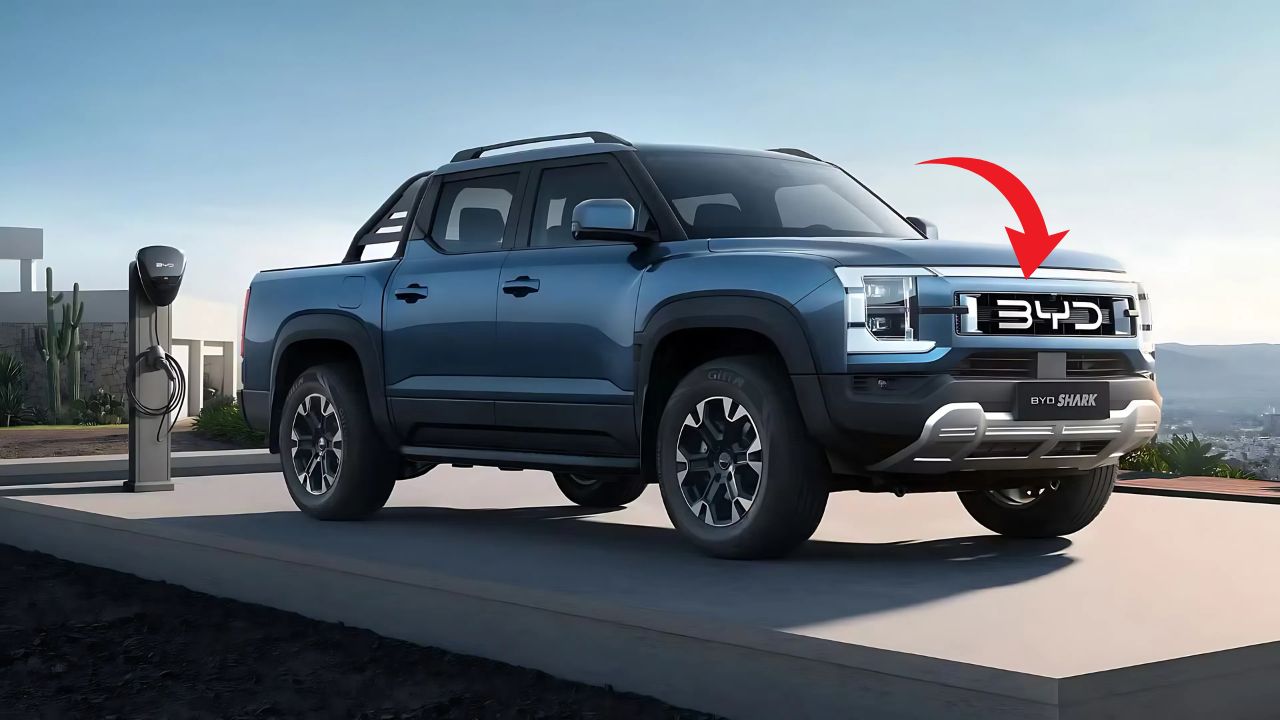Australia’s ute market faces its biggest disruption in decades as BYD prepares to launch the Shark 6. This plug-in hybrid pickup truck combines traditional utility with cutting-edge electrification technology.
The timing couldn’t be more perfect, with Australian tradies and outdoor enthusiasts increasingly interested in fuel-efficient alternatives. BYD’s entry promises to shake up a segment long dominated by established players.

Revolutionary Plug-in Hybrid Technology
The Shark 6 represents BYD’s first serious attempt at the Australian ute market. Unlike pure electric vehicles, this plug-in hybrid system addresses range anxiety while delivering impressive efficiency.
The powertrain combines a turbocharged petrol engine with electric motors for best-of-both-worlds performance. Daily commuting can rely entirely on electric power, while longer trips benefit from the petrol engine’s extended range.
Powertrain Architecture Explained
BYD’s hybrid system uses a sophisticated arrangement that maximizes efficiency across different driving scenarios. The electric motors handle low-speed operations, while the petrol engine engages for highway driving and heavy loads.
Power distribution happens seamlessly without driver intervention. The system automatically selects the most efficient combination of electric and petrol power based on driving conditions.
Total system output reaches impressive levels that compete directly with traditional V6 engines. However, fuel consumption remains significantly lower than conventional powertrains under most conditions.
Electric-Only Driving Capability
Pure electric range extends to approximately 100 kilometers on a single charge. This covers most Australian daily commuting scenarios without requiring any petrol consumption.
Electric-only mode operates silently, making early morning departures more neighborly. The instant torque delivery provides excellent acceleration from standstill situations.
Charging the battery pack takes several hours on standard household power. Faster AC charging reduces this time significantly when compatible chargers are available.
Design and Construction Philosophy
BYD has crafted the Shark 6 to meet Australian conditions and expectations. The design balances modern aesthetics with practical functionality required in the ute segment.
Build quality reflects lessons learned from BYD’s passenger car experience. However, the Shark 6 incorporates additional reinforcement and protection needed for commercial applications.
Exterior Styling Approach
The front end combines aggressive styling with functional aerodynamics. LED headlights and distinctive grille design create strong road presence without appearing overly flashy.
Side profile maintains classic ute proportions while incorporating modern design elements. The result feels familiar to traditional ute buyers while signaling advanced technology underneath.
Wheel arch cladding and protective trim pieces prepare the vehicle for off-road adventures. These elements also enhance visual toughness that Australian ute buyers expect.
Interior Design Priorities
The cabin prioritizes durability and functionality over luxury appointments. Hard-wearing materials resist damage from work boots, tools, and outdoor equipment.
Storage solutions throughout the interior cater to tradies and recreational users. Multiple compartments keep small items organized and easily accessible.
Technology integration remains user-friendly without overwhelming less tech-savvy operators. Physical controls for essential functions ensure reliability in challenging conditions.
Towing and Payload Capabilities
Australian ute buyers demand serious capability for towing boats, caravans, and work trailers. The Shark 6’s hybrid powertrain actually enhances some aspects of towing performance.
Maximum towing capacity reaches competitive levels with established ute models. Electric motor torque provides excellent pulling power from low speeds, ideal for boat ramp launches.
Payload Performance Analysis
The dual-cab configuration balances passenger space with cargo capacity. Rear seat passengers enjoy reasonable comfort during extended journeys.
Tub dimensions accommodate standard Australian pallets and building materials. Tie-down points and optional accessories support various cargo securing needs.
Ground clearance and approach angles enable access to construction sites and recreational areas. However, the Shark 6 isn’t positioned as an extreme off-road vehicle.
Towing Technology Features
Trailer sway control helps maintain stability during windy conditions or when passing trucks. This electronic system intervenes before dangerous situations develop.
Integrated brake controllers eliminate the need for aftermarket installations. The system coordinates trailer brakes with the hybrid powertrain for smooth operation.
Reversing cameras include trailer guidelines that adjust based on trailer dimensions. This feature simplifies backing up boats, caravans, and work trailers.
Technology and Connectivity Systems
Modern ute buyers expect comprehensive technology integration for both work and personal use. The Shark 6 delivers connectivity features that support various lifestyle demands.
The infotainment system includes navigation with real-time traffic updates. This proves valuable for tradies navigating to different job sites throughout the day.
Work-Focused Technology
Multiple 12V and USB charging points throughout the cabin keep devices powered. Additional outlets in the tub area support portable tools and equipment.
Smartphone integration allows hands-free calling and messaging. Voice commands keep drivers focused on the road during important business conversations.
Fleet management integration helps business owners track vehicle usage and maintenance needs. These features prove valuable for companies operating multiple vehicles.
Safety and Driver Assistance
Comprehensive safety systems protect occupants and other road users. Forward collision warning with automatic emergency braking prevents many common accidents.
Lane departure warning helps maintain proper road position during long highway drives. Driver fatigue monitoring suggests rest stops during extended journeys.
Blind spot monitoring proves particularly valuable when towing large trailers. The system alerts drivers to vehicles in areas obscured by trailer width.
Fuel Economy and Environmental Benefits
The Shark 6’s primary advantage lies in significantly improved fuel economy compared to traditional utes. Daily electric-only operation can virtually eliminate petrol consumption for many users.
When the petrol engine operates, efficiency remains impressive due to the hybrid system optimization. The electric motors assist during acceleration, reducing engine load and fuel consumption.
Real-World Efficiency Expectations
Users with regular charging access should achieve remarkable fuel economy figures. Short trips and daily commuting may require minimal petrol consumption throughout the week.
Highway driving with trailer loads will increase fuel usage, but still significantly below traditional utes. The hybrid system continues providing efficiency benefits even under heavy loads.
Combined cycle fuel economy ratings represent substantial improvements over conventional alternatives. These savings accumulate significantly over typical vehicle ownership periods.
Environmental Impact Considerations
Lower fuel consumption directly translates to reduced emissions during operation. The environmental benefit increases when charging occurs from renewable energy sources.
Battery production does create some environmental impact, but lifecycle analysis shows net benefits. The reduced fuel consumption over vehicle life typically outweighs manufacturing impacts.
End-of-life battery recycling continues improving as electric vehicle adoption grows. Valuable materials recovery reduces the need for new mining operations.
Market Positioning and Competition
The Shark 6 enters Australia’s most competitive vehicle segment, challenging established favorites like the Ford Ranger and Toyota HiLux. BYD’s strategy focuses on efficiency advantages rather than direct capability competition.
Pricing strategy aims to make hybrid technology accessible to traditional ute buyers. The fuel savings potential helps justify any premium over conventional alternatives.
Competitive Advantages Analysis
Fuel economy provides the Shark 6’s most compelling advantage over traditional competitors. Rising fuel costs make this benefit increasingly valuable for high-mileage users.
Electric-only operation offers unique benefits for urban work applications. Silent running enables early morning or late evening operations without disturbing neighborhoods.
Modern technology integration exceeds what many traditional ute manufacturers offer. Younger buyers particularly appreciate comprehensive connectivity and safety features.
Market Challenge Areas
Brand recognition remains BYD’s biggest hurdle in the Australian ute market. Traditional buyers show strong loyalty to established manufacturers with proven track records.
Service network coverage doesn’t yet match competitors with decades of Australian presence. Rural and remote area support may concern buyers in regional areas.
Resale value uncertainty affects leasing costs and ownership economics. However, strong global hybrid adoption trends should help address these concerns over time.
Charging Infrastructure and Usage Patterns
The Shark 6’s plug-in hybrid design reduces charging infrastructure dependence compared to pure electric vehicles. However, regular charging maximizes the efficiency benefits.
Home charging using standard household outlets works for most users. Overnight charging easily replenishes the battery pack for next-day electric-only driving.
Public Charging Opportunities
Workplace charging enables electric-only operation throughout the workday. Many construction sites and commercial facilities now provide charging access.
Shopping center and destination charging extends electric-only range during errands. These opportunities reduce overall fuel consumption without requiring dedicated charging stops.
DC fast charging capability enables rapid top-ups during longer journeys. However, the petrol engine eliminates the range anxiety associated with pure electric vehicles.
Charging Cost Economics
Electricity costs typically prove much lower than petrol for equivalent distances. The exact savings depend on local electricity rates and petrol prices.
Time-of-use electricity pricing can further reduce charging costs. Programming charging during off-peak periods maximizes economic benefits.
Solar panel integration at home or work can virtually eliminate charging costs. This renewable energy approach maximizes both economic and environmental benefits.
Off-Road Capability Assessment
Australian ute buyers frequently venture beyond sealed roads for work and recreation. The Shark 6 provides reasonable off-road capability while maintaining on-road efficiency.
Ground clearance and departure angles handle most construction sites and camping areas. However, extreme off-road enthusiasts may prefer traditional alternatives.
Four-Wheel Drive System
All-wheel drive capability engages automatically when traction conditions require it. The system distributes power between front and rear axles for optimal grip.
Electric motor torque vectoring can send power to individual wheels as needed. This technology provides advantages over traditional mechanical systems in some situations.
Hill descent control maintains safe speeds on steep declines. The regenerative braking system actually provides more precise control than traditional engine braking.
Terrain Management Systems
Multiple driving modes optimize performance for different surface conditions. Sand, mud, and rock modes adjust throttle response and traction control settings.
Wading depth capabilities handle creek crossings and flooded roads. However, extreme water crossing should be avoided to protect electrical components.
Approach and departure angles accommodate most Australian off-road scenarios. The Shark 6 won’t match dedicated off-road vehicles, but handles typical situations well.
Service and Maintenance Requirements
Hybrid powertrains require specialized knowledge for service and repairs. BYD is training technicians and establishing service capabilities before the Shark 6 launch.
Maintenance schedules differ from traditional vehicles due to the electric components. However, overall maintenance costs may actually decrease due to reduced engine wear.
Routine Maintenance Differences
Oil change intervals may extend due to reduced engine operation time. The electric motors require minimal maintenance compared to traditional mechanical components.
Brake pad life typically increases significantly due to regenerative braking. The electric motors handle much of the braking force, reducing mechanical brake wear.
Air filter and spark plug replacement schedules remain similar to conventional vehicles. However, overall engine hours accumulate more slowly due to electric-only operation.
Warranty and Support Coverage
Comprehensive warranty coverage provides peace of mind for early adopters. BYD offers separate warranties for the vehicle and hybrid system components.
Battery warranty coverage extends for significant periods and mileage. This protection addresses concerns about expensive battery pack replacement costs.
Roadside assistance includes hybrid-specific support capabilities. Technicians receive training to handle both electric and conventional powertrain issues.
Launch Timeline and Market Entry

BYD plans to introduce the Shark 6 to Australia during 2025, with initial availability in major metropolitan areas. Regional expansion will follow as dealer networks and service capabilities develop.
Pre-launch testing in Australian conditions ensures the vehicle meets local requirements. Hot weather, dusty conditions, and rough roads all receive specific attention.
Distribution Strategy
Initial sales will focus on major cities where charging infrastructure and service support are most developed. This approach allows BYD to refine operations before wider expansion.
Fleet sales may represent early adoption opportunities for progressive companies. Government and utility fleet trials can demonstrate capabilities to potential buyers.
Dealer training programs ensure sales staff understand hybrid technology benefits. Educating customers about plug-in hybrid operation will be crucial for market acceptance.
Production and Supply Considerations
Global demand for hybrid vehicles continues growing, potentially affecting Australian supply. BYD is expanding production capacity to meet worldwide demand.
Local assembly consideration could improve supply security and pricing competitiveness. However, initial sales will likely rely on imported vehicles.
Parts and service supply chains require establishment to support long-term ownership. BYD is working with local partners to ensure adequate support infrastructure.
FAQs:
Q: What is the electric-only range of the BYD Shark 6?
A: The Shark 6 can travel approximately 100 kilometers on electric power alone before the petrol engine needs to engage.
Q: How does the Shark 6’s towing capacity compare to traditional utes?
A: The Shark 6 offers competitive towing capacity with established ute models, enhanced by electric motor torque for excellent low-speed pulling power.
Q: When will the BYD Shark 6 be available in Australia?
A: BYD plans to launch the Shark 6 in Australia during 2025, with initial availability in major metropolitan areas.

